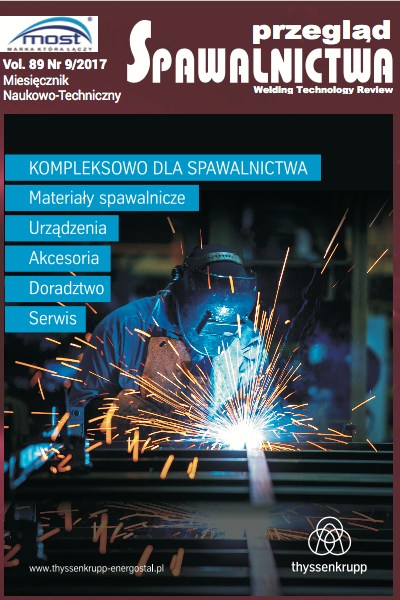Peculiarities of simulation of the additive process of forming of 3D products from steel 09G2S
Main Article Content
Abstract
The results of modeling of thermal elds, stresses, deformations and displacements in formation of an additive structure of 09G2S steel on a substrate are presented. An interdisciplinary research computational package COMSOL Multiphysics was used for computer modeling. Effect of the temperature on physicochemical parameters of steel was taken into account in the work. The results for modeling were obtained using Gleeble 3800 a complex for simula- tion of thermal deformation state of welding thermal cycle. Some physical-thermal properties of 09G2S steel were calculated using JmatPro 6.0 software package. Carried investigation showed that the highest level of residual stresses and deformations in additive deposition of 09G2S steel layers on the substrate is reached at the boundary of the rst layer and substrate and makes 280320 MPa. Stresses between the layers of deposited metal are signi cantly lower (to 50 MPa). It is determined that the increase of the number of deposited layers provokes nonlinear rise of a level of stress at the additive layer/substrate boundary and does not depend on the number of deposited layers in time. In additive man- ufacturing process, preheating to at least 300÷320 °C tem- perature should be used to prevent noticeable deformation of the substrate. Developed software can be used for mathematical modeling of additive process of formation of steel, titanium and aluminum alloys structures. Ref. 12, Figures 7.
Streszczenie
Przedstawiono wyniki modelowania pól termicznych, naprężeń, odkształceń i przemieszczeń przy formowaniu konstrukcji addytywnej ze stali 09G2S na podkładce. Dla dokonanego modelowania komputerowego wykorzystano pakiet dla międzydyscyplinarnych badań COMSOL Multiphysics. W pracy uwzględniono wpływ temperatury na parametry zykochemiczne stali. Wyniki dla modelowania otrzymano z wykorzystaniem kompleksu imitowania stanu termo-odkształceniowego cyklu termicznego spawania Gleeble 3800. Właściwości fizyko-termiczne stali 09G2S obliczono za pomocą pakietu JmatPro 6.0. Przeprowadzone badania świadczą, że przy nanoszeniu addytywnym warstw stali 09G2S na podkład największy poziom naprężeń resztkowych i odkształceń osiąga się na granicy pierwszej warstwy i podkładki i stanowi 280÷320 MPa. Naprężenia miedzy warstwa- mi metalu napawanego są znacznie niższe (do 50 MPa). Ustalono, że ze wzrostem ilości warstw naniesionych poziom naprężeń na granice warstwa addytywna/podkład wzrasta nieliniowo i z czasem nie zależy od ilości warstw nanoszonych. Przy procesie addytywnym dla zapobiegania odkształcenia podkładu należy stosować poprzednie nagrzewanie do temperatur 300÷320 °Ð¡. Te programy mogą być stosowane dla modelowania matematycznego procesu formowania konstrukcji ze stali i stopów aluminiowych.
Downloads
Article Details
Creative Commons CC BY 4.0 https://creativecommons.org/licenses/by/4.0/
Welding Technology Review (WTR) articles are published open access under a CC BY licence (Creative Commons Attribution 4.0 International licence). The CC BY licence is the most open licence available and considered the industry 'gold standard' for open access; it is also preferred by many funders. This licence allows readers to copy and redistribute the material in any medium or format, and to alter, transform, or build upon the material, including for commercial use, providing the original author is credited.
References
Zhukov V. V., Grigirenko G. M., Shapovalov V.A.: Additive manufacturing of metal products (Review), The Paton Welding Journal, No. 5-6, 2016, pp. 137-142.
Akhonin S. V., Vrzhizhevsky E. L., Belous V. Yu.,Petrichenko I. K.: Electron beam 3D-deposition of titanium parts, The Paton Welding Journal, No. 5-6, 2016, pp. 130-133.
Korzhik V. N., Khaskin V. Yu., Grinyuk A. A. et. al.: 3D-printing of metallic volumetric parts of complex shape based on welding plasma-arc technologies (Review), The Paton Welding Journal, No. 5-6, 2016, pp. 117-123.
Kaufui V. Wong, Aldo Hernandez: A Review of Additive Manufacturing, International Scholarly Research Network Mechanical Engineering, 2012, Vol. 2012, Article ID 208760, 10 pages, doi:10.5402/2012/208760.
P. M. Rizwan Ali, C. R. Hara Theja, Syed Mahammad Syed Saheb, C. Yuvaraj: Review on Diverse Materials Applied For Additive Manufacturing, International Journal for Research in Applied Science & Engineering Technology (IJRASET), Vol.3 Issue VII, July 2015, pp.16-20.
D. Ding, Z. Pan, D. Cuiuri, H. Li: Wire-feed additive manufacturing of metal components: technologies, developments and future interests, International Journal of Advanced Manufacturing Technology, No81, 2015, рр. 465-481.
V. A. Shapovalov, G. M. Grigorenko: Control of metal structure in process of solidi cation, Advances in electrometallurgy, No.2, 2015, pp. 51-54.
V. A. Shapoovalov, G. M. Grigorenko: Suppression of liquation processes in large ingots, Advances in electrometallurgy, No.1, 2015, pp. 26-30.
V. A. Kostin, V. V. Zhukov Modeling of processes of production of metallic parts using additive technologies: Proceedings of the 8th International Conference, Mathematical modeling and information technologies in welding and related processed. Edited by I. V. Krivtsun, September 19-23, Odessa, Ukraine.
O. V. Makhnenko, A. S. Milenin, E. O. Velikoivanenko, G. F. Rosynka et.al.: Modelling of temperature elds and stress-strain state of small 3D sample in its layer-by-layer forming using xBeam 3D Metal Printer, Proceedings of the 8th International Conference «Mathematical modeling and information technologies in welding and related processed. Edited by I. V. Krivtsun, September 19-23, Odessa, Ukraine.
